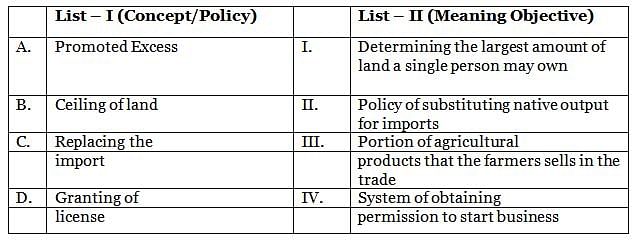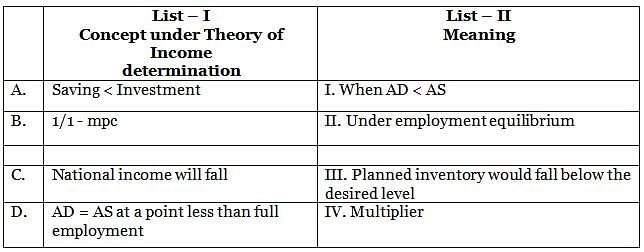CUET Economics Previous Year Solved Paper 3 (16 July 2022, Slot-2) - Humanities/Arts MCQ
30 Questions MCQ Test - CUET Economics Previous Year Solved Paper 3 (16 July 2022, Slot-2)
What was the main motive of British rule in India?
Match List - I with List - II.

Choose the correct answer from the options given below:

| 1 Crore+ students have signed up on EduRev. Have you? Download the App |
Put the following chronologically:
A. Installation of M/r. Tata Iron and Steel
B. Starting Railways serv ices during British Period
C. Collection of Population details in British India
D. Establishment of Planning commission
E. Existence of Karv e committee
Choose the correct answer from the options given below:
A. Installation of M/r. Tata Iron and Steel
B. Starting Railways serv ices during British Period
C. Collection of Population details in British India
D. Establishment of Planning commission
E. Existence of Karv e committee
Choose the correct answer from the options given below:
Identify the correct statements from the following:
A. Currency is issued by the nation’s Central Bank
B. To address the budget deficit, Central Bank sends money to the government
C. The economy’s foreign exchange reserves are preserved by Central Bank
D. Central Bank does not control money supply and credit through monetary policy
E. Central Bank gives loans to the com mercial Banks for short term
Choose the correct answer from the options given below:
Commercial banks have generated Rs. 12,000 crores and CRR is 25%. Initial payments will be in the amount of:
Match List - I with List - II.

Choose the correct answer from the options given below:
Put the following schemes chronologically:
A. Start of Jan Dhan Yojana
B. Mahatma Gandhi National Rural Employment Guarantee Act
C. Study group formed by the Planning Commission to estimate the number of poor in India.
D. Task force on projection of minimum needs and effective consumption demand.
E. Food for work programme was launched.
Choose the correct answer from the options given below:
Identify the correct statements from the following:
A. Revenue expenditure is any layout that result in a decrease in financial assets or an increase in financial liabilities
B. Capital expenditure is expenditure which results in creation of financial assets or reduction infinancial liabilities C. Capital receipts are receipts which leads to reduction in financial assets or creation of liability
D. Revenue receipts are receipts which lead to decrease in financial assets or increase of financial liability
E. Revenue receipts are receipts which neither lead to reduction in financial assets nor creation of financial liability Choose the correct answer from the options given below:
If NNPMP = Rs. 5,330, indirect tax = Rs. 1,770 and consumption of fixed capital = Rs. 1,550 then GNPFC will be x. The value of x is.
Which of the following is a factor income?
Identify the stock v ariable from the following:
GDPMP will be equal of GDPFC if
Match List - I with List - II.

Choose the correct answer from the options given below:
Identify the correct statements from the following:
A. Fees to a mechanic paid by a firm is not included in the estimation of national income
B. Income tax paid by an indiv idual is not included in national income
C. Interest paid by a garment manufacture on a loan taken from bank is included in national income
D. Payment of old age pension will not be included in national income as it is a transfer payment
E. Insurance premium paid by household to an insurance company is not included in the estimation of national income
Choose the correct answer from the options given below:
Identify the correct statement from the following:
A. The Household’s inv esting is not considered to be the cost of building a residence
B. Net factor revenue from overseas includes money from Exports
C. The sum of factor incomes equals the net value added
D. The assessment of national income takes into account the market value of both final and intermediate items
E. Profit earned by non-resident company in India is a part of domestic income of India
Choose the correct answer from the options given below:
W hich of the following correctly represents value at market price?
When all of an economy’s output is sold during a single accounting year, the value of output is represented by:
If a farmer sells wheat to miller for Rs. 500 and miller sells flour to baker for Rs. 700 and baker sells bread to the consumer for Rs. 1,000, then total value added by miller and baker is:
Match List - I with List - II.

Choose the correct answer from the options given below:
Identify the correct statement from the following:
A. Consumption curve starts from the origin
B. The sum of APC and APS is equal to 1
C. Aggregate demand and market demand mean the same
D. The value of MPC and MPS varies between 0 and 1
E. At breakeven point sav ing is zero
Choose the correct answer from the options given below:
In a time of deflation, the Central Bank should:
Identify the monetary invntion that can Close the inflationary group:
Actual aggregate demand’s gap from that needed to achieve full employment equilibrium is referred to as:
At equilibrium level of income in an economy:
If the ratio between MPC and MPS is 4 : 1, the value of investment multiplier will be:
In an economy if equilibrium level of national is Rs. 2,000 crores. Autonomous consumption = Rs. 400 crores and Investment expenditure = Rs. 200 crores, then MPC will be:
In an economy MPS = 0.20 and inv estment is increased by Rs. 400 crores, than total increase in income is ________ Crores.
_____ is included in the government budget as a capital receipt.
Arrange the following in correct chronological order:
A. Goods and Serv ice Tax came into effect
B. WTO was founded
C. GATT was established
D. Demonetization in India
E. Privatization of Air India
Choose the correct answer from the options given below:
The cause for the demand curve’s movement is:

















